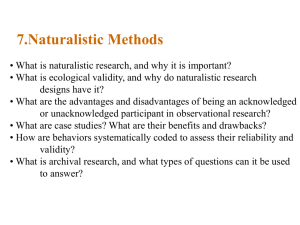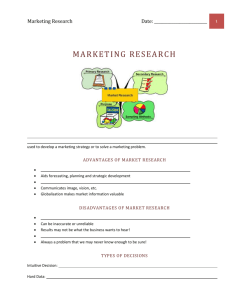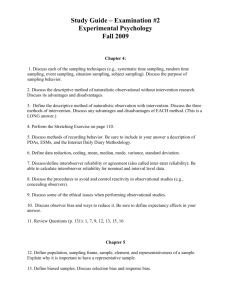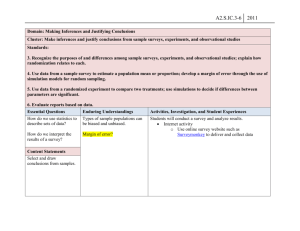DESCRIPTIVE RESEARCH DESIGNS
advertisement
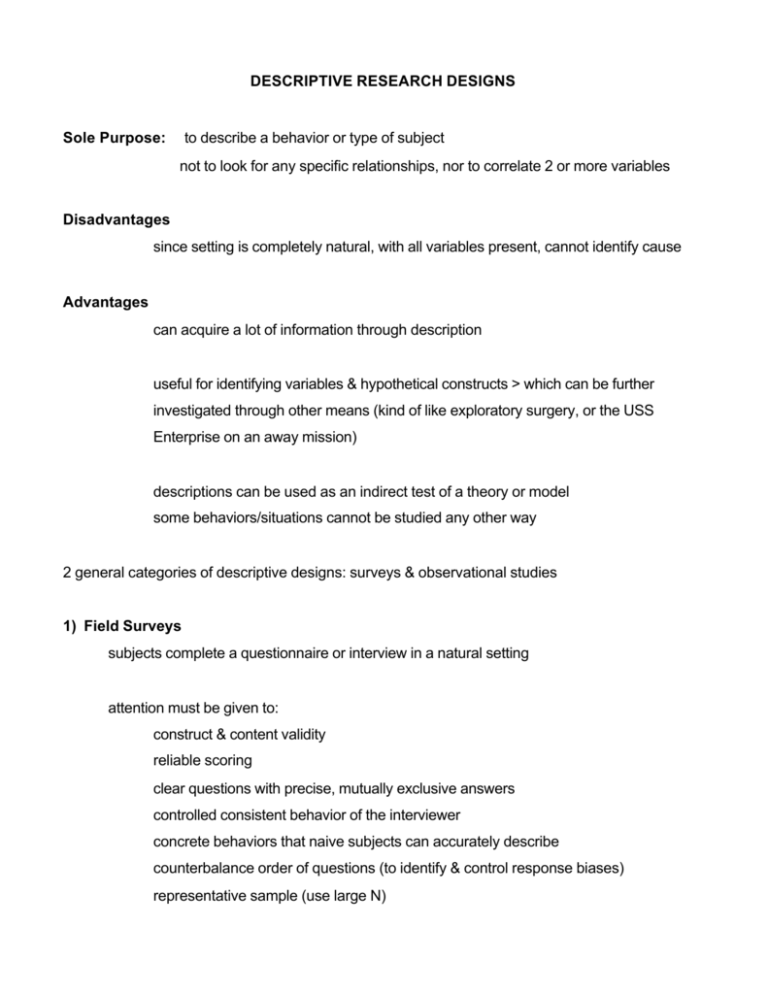
DESCRIPTIVE RESEARCH DESIGNS Sole Purpose: to describe a behavior or type of subject not to look for any specific relationships, nor to correlate 2 or more variables Disadvantages since setting is completely natural, with all variables present, cannot identify cause Advantages can acquire a lot of information through description useful for identifying variables & hypothetical constructs > which can be further investigated through other means (kind of like exploratory surgery, or the USS Enterprise on an away mission) descriptions can be used as an indirect test of a theory or model some behaviors/situations cannot be studied any other way 2 general categories of descriptive designs: surveys & observational studies 1) Field Surveys subjects complete a questionnaire or interview in a natural setting attention must be given to: construct & content validity reliable scoring clear questions with precise, mutually exclusive answers controlled consistent behavior of the interviewer concrete behaviors that naive subjects can accurately describe counterbalance order of questions (to identify & control response biases) representative sample (use large N) surveys may be mailed or conducted over the telephone Mailed: if need large N or if questionnaire is long problems: could take a while & not all surveys will be returned questions representativeness of the sample should have at least 50% return rate to be considered adequate to increase return rate: include a cover letter, ensure survey has face validity, use only brief questions with simple instructions, use a small reward, send a reminder letter Telephone: structured & closed ended questions (no free associations please) usually higher response rate subjects who don’t participate may be too busy or too wary make sure intro is straightforward & friendly Identifying the Population & Selecting the Sample identify all subgroups in the population in an unbiased manner best to use probability sampling techniques (random or stratified random) otherwise can use one of the following cluster sampling: certain groups are randomly sampled & all subjects in them are observed convenience sampling: quota sampling: study subjects who are convenient using convenience sampling, with the restriction that the sample has the same % of each subgroup as that found in the pop snowball sampling: “and they told two friends, and so on, and so on...” Potential biases: time of telephone call volunteer bias (people with strong opinions, or bored, are most likely to respond) the silent majority? predictive validity? How you feel today may not be how you feel tomorrow Analysis of Survey Results use descriptive stats to check for significant correlations between responses from different questions (see if significant using inferential stats) compute “margin of error” = confidence interval for frequency data 2) Observational Studies descriptions based only on unobtrusive (covert) observations of the subjects 3 general techniques naturalistic observation unstructured, unsystematic observation of a wide range of behaviors or situations systematic naturalistic observation systematic observations of a specific behavior or situation participant observation the investigator “infiltrates” the group being observed (like a spy) takes part in group activities but true identity and purpose are concealed Advantages 100 % natural > no subject reactivity or demand characteristics Disadvantages 1. experimenter expectations (esp in participant observation) 2. lack of informed consent 3. usually have to rely on convenience samples 4. mostly qualitative data: verbal descriptions based on visual observations may lack precision & accuracy (observer bias) & not very sensitive Purpose to identify variable which might be important indirect tests of models or predictions To increase Reliability & decrease Bias develop well defined scoring criteria use time sampling techniques employ multiple observers use double blind procedures videotape (if possible) obtain more random samples to increase external validity the “data” in descriptive research designs is frequently based on observations of actual behavior or the responses to questions ... but there other types/sources of data ... archival research: written records allows access to otherwise unobservable behaviors can verify subjects’ self-reports disadvantages may not have access to all records difficult to get informed consent records are only as goos as the people who took them ex post facto research a study of the events after they have occurred (archival research is necessarily ex post facto) can also obtain subjects responses after the event (rely on recall, self-reports) data is unreliable cannot precisely quantify past events cannot ensure that past events reliably occurred for all subjects case studies detailed observations of one situation or one person case study (longitudinal, prospective): subject to time-related confounds case history (archival, retrospective): poor reliability & validity selection of the “case” is not usually truly random but convenient Program Evaluation procedures for developing & evaluating social programs 1. needs assessment identify what’s needed & whether the program will be used 2. program planning design the program - methods 3. program monitoring make sure program is implemented and clients are using it 4. outcome evaluation is the program having the intended effect? data for each phase collected through descriptive research methods


